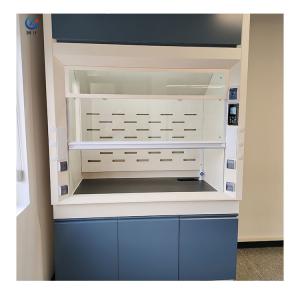
Add to Cart
The steel fume hood, also known as a steel exhaust hood or a steel laboratory hood, is a must-have in laboratories and industrial settings. It is designed to control and remove hazardous fumes, gases, and particles, thereby creating a safe working environment.
Of course, it is essential to receive proper training and follow safety protocols when using this device. Individuals should understand the guidelines and procedures related to their laboratory or industrial settings to ensure the effective and safe use of the fume hood.
Steel fume hoods are designed to provide a safe and secure environment for workers who require access to hazardous substances. The hoods are constructed of high-quality stainless steel, offering durability and corrosion resistance, while their enclosed workspace is lined with a chemical-resistant material. Furthermore, these fume hoods are connected to an exhaust system, which includes a fan or blower that pulls hazardous fumes away from the workspace. A sash or door at the front of the fume hood acts as a barrier, allowing workers to observe and access the interior while also keeping hazardous fumes contained.
To ensure safety and containment of hazardous substances, fume hoods use the principles of airflow and ventilation. The rate of air entering the hood opening, or face velocity, is carefully managed at a specific level. Furthermore, these fume hoods may include additional safety features, such as alarms, airflow monitors, and fire suppression systems.
Steel fume hoods are extensively used in various industries and settings, from chemical laboratories to educational institutions. They provide a controlled environment and safeguard personnel from exposure to hazardous substances, volatile reagents, and toxic fumes. In chemical and pharmaceutical industries, steel fume hoods are used to handle and manipulate potent ingredients during drug development and production processes. Research and development facilities also rely on the hoods to provide a safe environment for experiments, sample analyzing, and chemical investigations. Environmental testing laboratories utilize fume hoods to analyze air, water, and soil samples for pollutants, toxins, and contaminants, and prevent the contamination of the laboratory environment. Additionally, steel fume hoods are used in industrial manufacturing processes to control emissions and protect workers. Finally, educational institutions also make use of these hoods for laboratory experiments, ensuring student safety by containing airborne substances generated during the process.
Our company provides comprehensive technical support and service for our Steel Fume Hood products. We have a team of experienced technicians who are available to provide any assistance you may need. Our technicians are available to answer any questions you may have about our products and provide advice on installation, maintenance, and troubleshooting.
We also provide after-sales services, including repairs and replacement parts. We can also provide training on our products and offer advice on best practices for optimal performance and safety. We are committed to helping our customers get the most out of their Steel Fume Hoods and to providing the best possible customer service.
Steel Fume Hoods should be packed and shipped in a way that protects the hood from any potential damage while in transit. The following are some general guidelines for packaging and shipping Steel Fume Hoods:
Product detail: